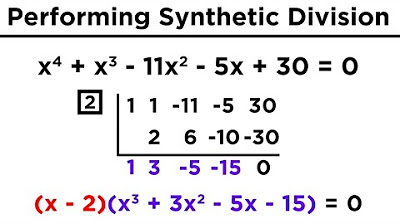Introduction to Complex Solutions of Polynomials (Precalculus - College algebra 35)
TLDRThis video script delves into the fascinating world of complex zeros of polynomials, a topic that will be further explored in subsequent videos. The presenter explains that every polynomial can be factored into linear or irreducible quadratic factors over the real number system, with linear factors corresponding to real x-intercepts and irreducible quadratics leading to complex solutions. The concept of complex conjugate pairs is introduced, emphasizing that every complex solution comes with a guaranteed partner, forming these pairs. The script also clarifies that the degree of a polynomial, when considering complex numbers, equals the number of linear factors or solutions one can obtain. This is a significant shift from the real number system where the degree only indicates the maximum possible x-intercepts. The video concludes with a discussion on how understanding complex solutions allows for further factorization of irreducible quadratics over complex numbers, leading to a complete set of solutions that match the polynomial's degree. Upcoming videos will demonstrate how to construct polynomials from these complex solutions.
Takeaways
- 📚 Every polynomial can be factored over the real number system into linear or irreducible quadratic factors.
- 🔍 Allowing complex solutions enables further factorization of polynomials into linear factors, with the degree of the polynomial equating to the number of factors.
- 🌟 The concept of complex numbers is crucial, where a complex number is a real part plus or minus an imaginary part, derived from the square root of a negative number.
- 🎓 Complex solutions always come in conjugate pairs, meaning for every complex solution, there is a corresponding conjugate with the real part unchanged and the sign of the imaginary part reversed.
- 🔗 The quadratic formula plays a key role in generating complex conjugate pairs when dealing with irreducible quadratics, as it involves a plus or minus operation that naturally produces pairs.
- ✅ The degree of a polynomial, when factored over complex numbers, equals the number of linear factors and solutions, ensuring that every polynomial has as many solutions as its degree.
- 🧮 Real solutions do not come in pairs and can stand alone, whereas complex solutions always appear in conjugate pairs due to the nature of the quadratic formula.
- 🔑 The discriminant (the number inside the square root in the quadratic formula) determines whether a quadratic is reducible or irreducible; a negative discriminant results in complex solutions.
- 🛠️ Polynomials of odd degree must cross the x-axis at least once, which means there is at least one real solution.
- 🔍 For every irreducible quadratic factor in a polynomial, the degree is effectively reduced by two because it yields two complex solutions.
- 🌠 In the upcoming videos, the focus will be on building functions and polynomials from complex solutions, demonstrating their practical application in mathematics.
Q & A
What is the significance of complex zeros in polynomials?
-Complex zeros are significant because they allow for the complete factorization of polynomials over the complex number system. Every polynomial can be factored into linear or irreducible quadratic factors, and when complex solutions are allowed, the polynomial can be broken down into all linear factors.
How does the degree of a polynomial relate to the number of solutions when considering complex numbers?
-When considering complex numbers, the degree of a polynomial is equal to the number of linear factors, and thus also the number of solutions. This is because every linear factor contributes one solution, and complex solutions always come in conjugate pairs.
What is a complex conjugate pair?
-A complex conjugate pair consists of two complex numbers that have the same real part but opposite signs in their imaginary parts. For example, if you have a complex number 'a + bi', its conjugate is 'a - bi'.
Why do complex solutions always come in pairs when factoring polynomials?
-Complex solutions come in pairs due to the nature of the quadratic formula. When applied to an irreducible quadratic, it yields two solutions that are complex conjugates of each other, ensuring that for every complex solution, there is a corresponding pair.
How does the presence of complex solutions affect the factorization of a polynomial?
-The presence of complex solutions allows for the polynomial to be factored completely into linear factors over the complex number system. This means that every degree of the polynomial corresponds to a unique linear factor, and no higher degree terms remain.
What happens to the degree of a polynomial when an irreducible quadratic is present?
-When an irreducible quadratic is present in a polynomial, it effectively reduces the degree of the polynomial by two. This is because the irreducible quadratic contributes two complex solutions, which are counted as a single factorization step in the polynomial's factorization process.
Why is it important to consider both real and complex solutions when factoring a polynomial?
-Considering both real and complex solutions is important because it ensures that the polynomial is fully factored according to its degree. This is crucial for understanding the polynomial's behavior, such as its intersections with the x-axis (x-intercepts) and its overall structure.
What is the relationship between the discriminant and the irreducibility of a quadratic?
-The discriminant, which is the number inside the square root in the quadratic formula, determines whether a quadratic is reducible or irreducible. If the discriminant is negative, the quadratic is irreducible over the real numbers and its solutions will be complex.
How does the quadratic formula contribute to the formation of complex conjugate pairs?
-The quadratic formula inherently produces complex conjugate pairs because it involves a plus or minus operation on the square root of a negative number, which results in two solutions with opposite signs in the imaginary part.
What is the implication of a polynomial having an odd degree in terms of its real solutions?
-An odd degree polynomial must cross the x-axis at least once, implying that it has at least one real solution. This is due to the fundamental theorem of algebra, which guarantees at least one real root for polynomials of odd degree.
null
-null
How can one determine if a polynomial has all its solutions when considering complex numbers?
-One can determine if a polynomial has all its solutions by ensuring that the total number of solutions (real and complex) equals the degree of the polynomial. Since complex solutions come in pairs, the count must be even, and any real solution is counted individually.
Outlines
😀 Introduction to Complex Zeros of Polynomials
This paragraph introduces the concept of complex zeros of polynomials and their significance in factoring polynomials over complex numbers. It explains that every polynomial can be factored into linear or irreducible quadratic factors over the real number system. The video aims to explore complex zeros, their origin, applications, and how they enable the complete factorization of polynomials when complex numbers are considered. The importance of understanding complex conjugate pairs is emphasized, as every complex solution comes in such a pair, which is crucial for the factorization process.
🧮 Factoring Polynomials with Complex Solutions
The second paragraph delves into the process of factoring polynomials using complex solutions. It clarifies that allowing complex solutions means that the degree of the polynomial equals the number of linear factors one can obtain. This is a shift from the real number system, where the degree indicates the maximum number of x-intercepts. The concept of complex conjugate pairs is further explored, showing how they arise from irreducible quadratics and the quadratic formula. The paragraph also discusses why irreducible quadratics always result in complex conjugate pairs as solutions.
🔍 Degree and Solutions of Polynomials with Complex Numbers
This paragraph focuses on the relationship between the degree of a polynomial and the number of solutions when complex numbers are included. It illustrates that for a polynomial of degree six, there should be six solutions, which may include complex conjugate pairs. The explanation emphasizes that complex solutions always come in pairs due to the nature of the quadratic formula, and real solutions do not require pairing. The paragraph also touches on the idea that an odd-degree polynomial must cross the x-axis at least once, indicating a real solution.
🌟 Complex Solutions and Polynomial Factorization
The final paragraph of the script summarizes the key points discussed in the video. It reiterates that complex solutions allow for the factorization of polynomials into as many linear factors as the degree of the polynomial indicates. The video concludes by stating that in future videos, the process of building functions from complex solutions will be explored. This will involve creating polynomials based on these complex solutions, further emphasizing the practical applications of complex numbers in polynomial factorization.
Mindmap
Keywords
💡Complex Zeros
💡Polynomial Factorization
💡Real Number System
💡Complex Number System
💡Conjugate Pairs
💡Irreducible Quadratics
💡Quadratic Formula
💡Discriminant
💡X-Intercepts
💡Multiplicity
💡Imaginary Part
Highlights
The video introduces the concept of complex zeros of polynomials and their significance in future videos.
Every polynomial can be factored over the real number system into linear or irreducible quadratic factors.
Irreducible quadratics do not yield x-intercepts because they give complex solutions.
The degree of a polynomial equals the number of linear factors if complex solutions are allowed.
Complex solutions always come in conjugate pairs, with the real part unchanged and the imaginary part changing sign.
The quadratic formula creates complex conjugate pairs due to the plus and minus in the formula.
Irreducible quadratics are a result of a negative discriminant, leading to imaginary numbers.
Polynomials can be completely factored into linear factors and irreducible quadratics over complex numbers.
The degree of a polynomial equals the number of solutions when using complex numbers.
Complex solutions always come in pairs, ensuring an even number of complex solutions.
Real solutions do not require pairs, unlike complex solutions.
A degree seven polynomial must cross the x-axis at least once, ensuring one real solution.
The video emphasizes the importance of understanding complex solutions for further factoring polynomials.
The next videos will focus on building functions from complex solutions.
The video provides a comprehensive overview of the role of complex numbers in polynomial factorization.
Transcripts
Browse More Related Video

Finding ALL Solutions of Polynomials (Precalculus - College Algebra 37)

Complex Numbers: Operations, Complex Conjugates, and the Linear Factorization Theorem

AP Precalculus Practice Exam Question 23

Introduction to Solving Quadratics (Precalculus - College Algebra 16)

Creating Polynomials from Complex Solutions (Precalculus - College Algebra 36)

Solving Higher-Degree Polynomials by Synthetic Division and the Rational Roots Test
5.0 / 5 (0 votes)
Thanks for rating: